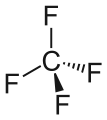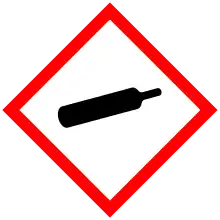Halotron I
Halotron I is a fire extinguishing agent based on the raw material HCFC-123 (93%) mixed with tetrafluoromethane and argon as propellants.
 | |
 Chemical structures of dichlorotrifluoroethane (top) and tetrafluormethane (bottom), the two major components of Halotron I | |
| Hazards | |
|---|---|
| Safety data sheet | Halotron |
| GHS pictograms |   |
| NFPA 704 (fire diamond) | |
| Lethal dose or concentration (LD, LC): | |
LC50 (median concentration) |
3.2% (4 hrs, inhalation) |
Except where otherwise noted, data are given for materials in their standard state (at 25 °C [77 °F], 100 kPa). | |
| Infobox references | |
Global emission concerns
It was originally introduced in 1992 to replace the severely ozone-depleting Halon 1211 (bromochlorodifluoromethane). Halon 1211 has a global warming potential of 1890, whereas Halotron I's GWP is 77, being a 96% reduction.[2]
Performance
In December 2011, Halotron I was tested against "hidden fires", spurred by the effectiveness its predecessor demonstrated on an in-flight fire aboard a Delta L-1011 flight on March 17, 1991. The test was conducted at UL, and demonstrated similar effectiveness as Halon 1211, with significantly less human and global harm.[3]
DOT classification
UN1956, Compressed Gases, N.O.S., Nonflammable Gas. IMCO CLASS: 2.2
References
- http://www.halotron.com/pdf/Halotron1_SDS.pdf
- https://www.fire.tc.faa.gov/2010Conference/files/Halon_Replacement_I/Boeing2BTPHandheld/CarloBTPupdatePres.pdf
- "R0201336.pdf" (PDF). NIST.gov. Retrieved December 23, 2017.

